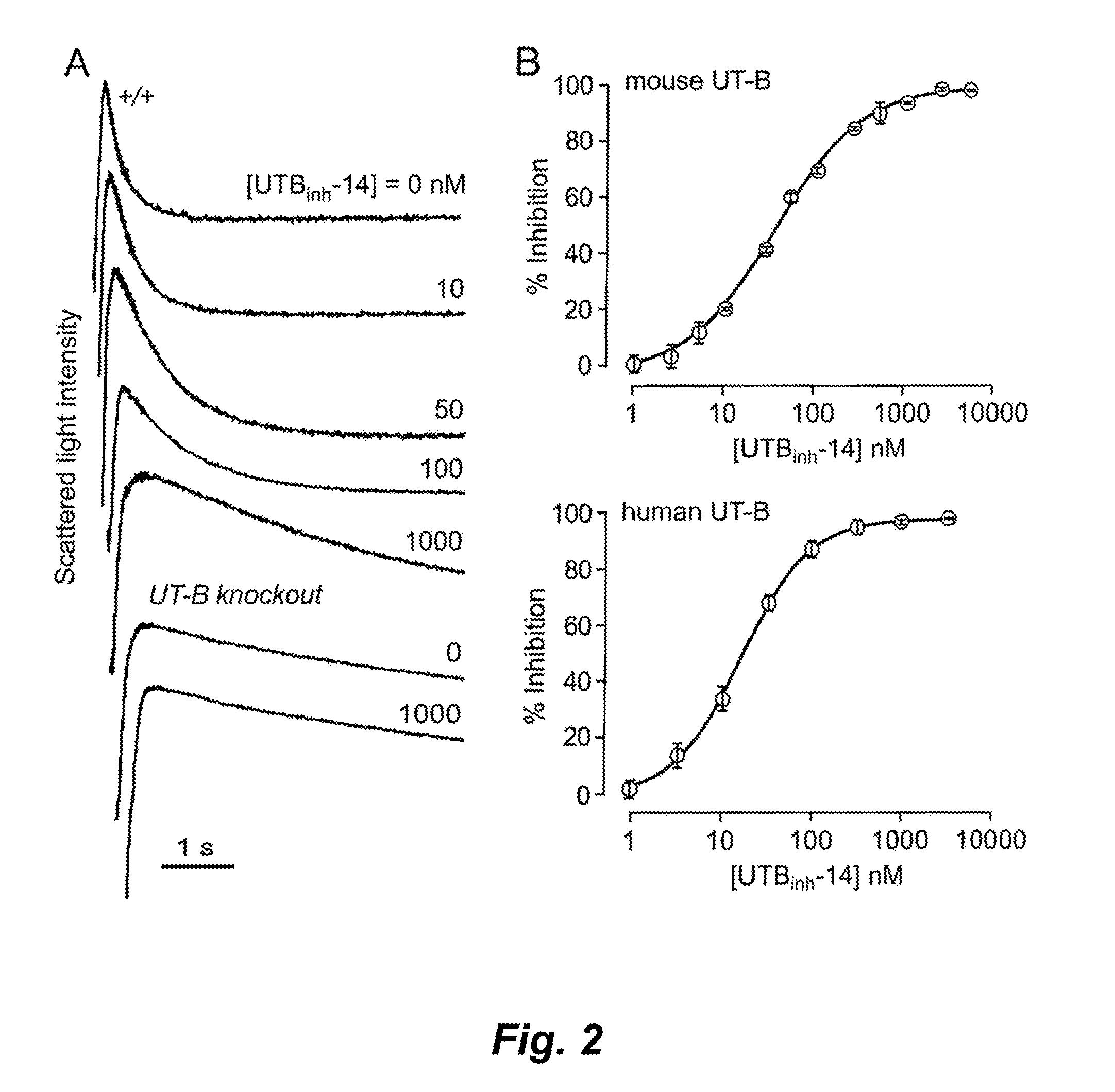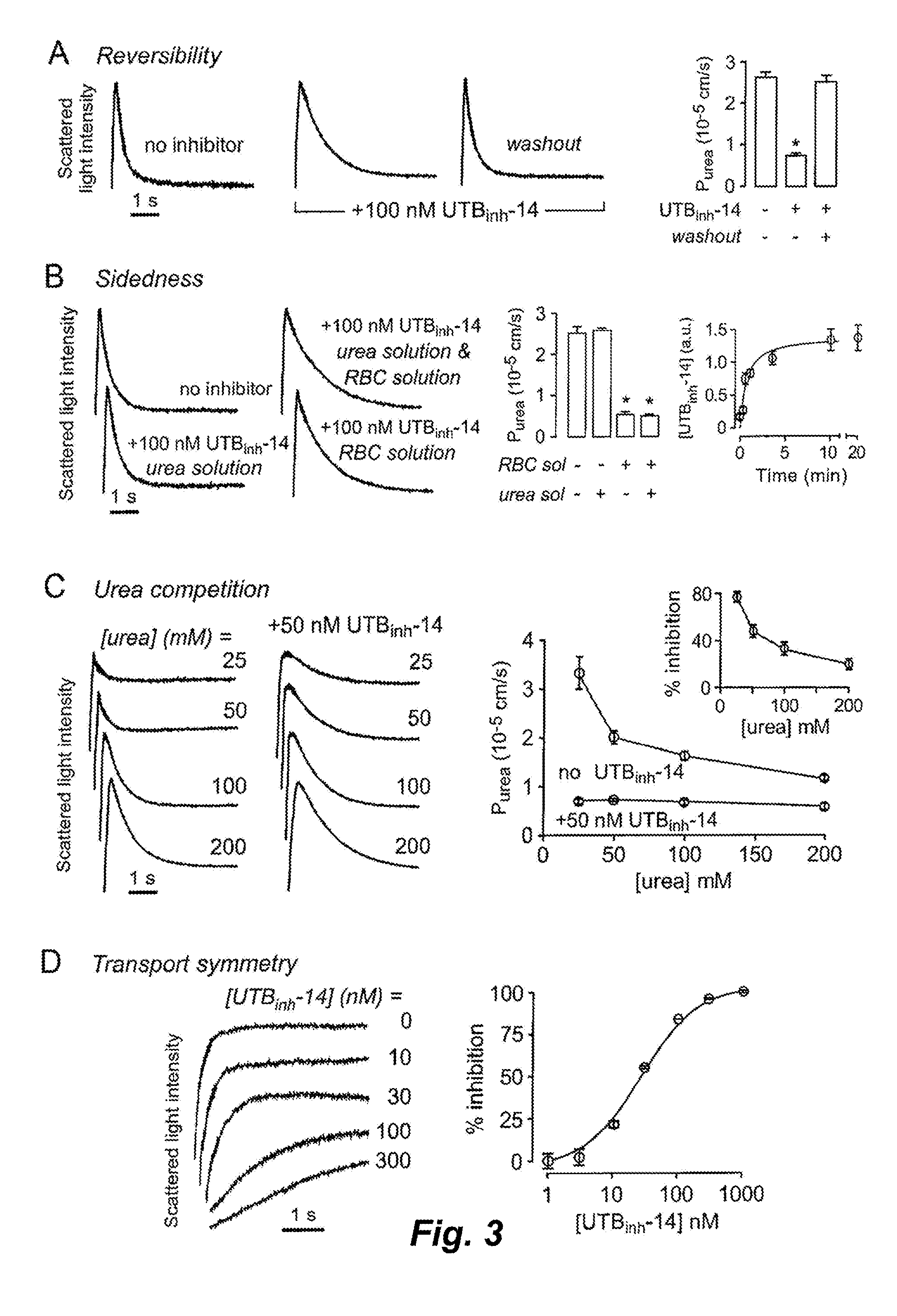Triazolothienopyrimidine compound inhibitors of urea transporters and methods of using inhibitors
a technology of urea transporter and compound inhibitor, which is applied in the direction of drug composition, extracellular fluid disorder, cardiovascular disorder, etc., can solve the problems of complex urea processing by the kidney, and potent and specific urea transport blockers have not been available, so as to inhibit the urea transport activity and reduce urine concentration.
- Summary
- Abstract
- Description
- Claims
- Application Information
AI Technical Summary
Benefits of technology
Problems solved by technology
Method used
Image
Examples
example 1
Identification of UT-B Inhibitors by High-Throughput Screening
[0378]One hundred thousand chemically diverse small molecules were screened in order to identify potent and selective inhibitors of UT-B that were suitable for efficacy studies in mice. Screening was performed using mouse erythrocytes, which strongly express UT-B and are highly water permeable because the cells also express aquaporin-1 (AQP1) water channels. The screening method involved assay of erythrocyte lysis in response to a large, outwardly directed gradient of acetamide, a urea analog that is transported efficiently by UT-B. A large, outwardly directed gradient of acetamide causes transient cell swelling, but little cell lysis, because UT-B-facilitated acetamide efflux limits water influx (see FIG. 1A). UT-B inhibition prevents acetamide efflux, allowing unopposed cell swelling and consequent cell lysis, which was recorded by reduced near-infrared light absorption at 710 nm. Acetamide, rather than urea or other ur...
example 2
Synthesis of UTBinh-14
[0381]UTBinh-14 (also called compound 1 herein) was synthesized as a highly pure (>99% by HPLC) crystalline powder according to a synthesis scheme illustrated in FIG. 1C and described in greater detail below. The synthesis involved reaction of 3-bromothiophene-2-carbaldehyde 11a with sodium azide in DMSO to generate an azidothiophene carbaldehyde (Gronowitz et al., Acta Chem. Scand. B 29:224-32 (1975)), which was oxidized using the Lindgren reaction (see, e.g., Lindgren et al., Acta Chem. Scand. 27:888-90 (1973)) to generate 3-azidothiophene-2-carboxylic acid 13a Steglich esterification (Neises et al., Angew Chem Int Ed 17:522-24 (1978)) gave the azido ester intermediate 14a. Arylsulfonylacetonitrile intermediate 6m, was generated by alkylation of 4-ethylbenzenethiol with bromoacetonitrile followed by oxidation with mCPBA. Lactam 15m was then synthesized by base-mediated [2+3] cycloaddition of 14a and 6m, and converted to UTBinh-14 using the PyBOP coupling reag...
example 3
Inhibition Potency of UTBinh-14
[0387]UT-B inhibition potency was assayed quantitatively by stopped-flow light scattering from the kinetics of urea influx in response to an inwardly directed urea gradient (see Materials and Methods above). Rapid mixing of an erythrocyte suspension with an equal volume of a hyperosmolar, urea-containing solution to give a 100 mM inwardly directly urea gradient produced rapid cell shrinking due to osmotic water efflux, followed by cell swelling as a consequence of urea (and water) influx. FIG. 2A shows light scattering kinetics at different UTBinh-14 concentrations, which was present in both the erythrocyte- and urea-containing solutions. Increasing UTBinh-14 concentration greatly slowed the kinetics of erythrocyte swelling. UTBinh-14 at 1 μM produced near 100% inhibition, as evidenced by the comparable swelling kinetics to that measured in erythrocytes from UT-B knockout mice (lower curves). UTBinh-14 did not inhibit urea transport in UT-B null erythr...
PUM
| Property | Measurement | Unit |
|---|---|---|
| time | aaaaa | aaaaa |
| density | aaaaa | aaaaa |
| density | aaaaa | aaaaa |
Abstract
Description
Claims
Application Information
 Login to View More
Login to View More - R&D
- Intellectual Property
- Life Sciences
- Materials
- Tech Scout
- Unparalleled Data Quality
- Higher Quality Content
- 60% Fewer Hallucinations
Browse by: Latest US Patents, China's latest patents, Technical Efficacy Thesaurus, Application Domain, Technology Topic, Popular Technical Reports.
© 2025 PatSnap. All rights reserved.Legal|Privacy policy|Modern Slavery Act Transparency Statement|Sitemap|About US| Contact US: help@patsnap.com



